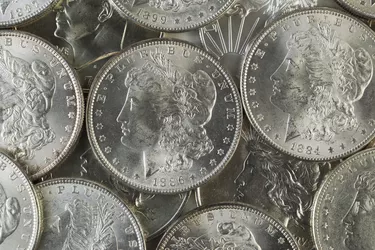
The term "silver certificate" is outdated and referred initially to paper certificates used in place of silver coins. For example, a one-dollar silver certificate had the same value as a silver dollar coin. Silver certificates were introduced in 1878 in response to the Fourth Coinage Act of 1873. This Act was meant to put an end to bimetal currencies by implementing a straight gold standard.
What's a 1935 Dollar Bill Worth?
Video of the Day
To distinguish between silver certificates and regular dollar bills, look at the top of the bill. If it reads "Federal Reserve Note" it is the standard kind; silver certificates read "Silver Certificate" instead. 1935 was the final year that $1 silver certificates were printed. Although 1935 dollar bills are fairly common, some varieties may be of additional value.
Video of the Day
The three primary colors of seals are blue, brown and yellow, and the series includes the plain 1935, followed by the letters A through H. A basic 1935 dollar bill silver certificate would be redeemable for its face value, and those that are uncirculated and in top condition can fetch up to $17.50.
Valuable 1935 Notes
The Series 1935A Experimental R and S Notes are worth much more. These have small, red-colored R and S letters printed on the right sides next to the seals to indicate specific kinds of paper that were experimented with. In pristine condition, either could be worth around $400.
A 1935 dollar bill with a yellow seal and darker paper could very well be a 1935A North Africa $1 note. These were issued to members of the U.S. military during World War II and could be worth around $285. There's also the 1935A Hawaii $1 note, which has the word Hawaii printed on the left side and back of the bill plus a brown seal. These were issued to respond to the Pearl Harbor Attack, and you might be able to get close to $200 for one.
If you have questions about coin or bill collections, contact an expert on the subject for help with authentication or valuation. A numismatist might be able to help guide you in making the right choice for your collection, whether it be to sell it or to keep it.
Consider also: How to Deposit Rolled Coins
One Dollar Silver Certificate History
American businesses disagreed with the Act because it did not allow for silver coins to be used in transactions, and thus they started investing in silver. By 1878, the Bland-Allison Act was passed, and it required the U.S. Treasury to buy a minimum amount of silver. This silver was then put into circulation as large-sized silver certificates, initially with varying denominations from $10 to $1,000. The $1, $2 and $5 denominations were not authorized until 1886, and they were on larger paper than we see today.
The larger certificates were replaced by smaller versions after U.S. Treasury Secretary Andrew W. Mellon and his committee recommended the smaller size; the new certificates appeared in 1929. After World War II, the demand for silver bullion rose, and the certificates continued to be produced until 1957. They were phased out in 1964 (the same year that dimes, quarters and half dollars started being made from silver), but they can still be redeemed for their face value, albeit in cash only.
If you wish to redeem one, you can try your local bank. You'll need to be a customer in order to complete this sort of transaction in the majority of cases.